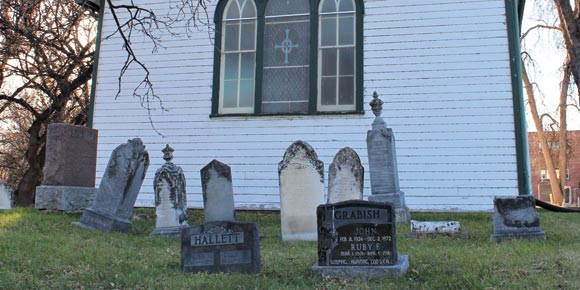As Halloween approaches, many people’s thoughts turn to ghosts and haunted places. What better setting for a scare than a graveyard!
Winnipeg has some beautiful old cemeteries where you just might catch a wandering spirit or help set the tone for a Halloween event. They are also important places for teaching us about our history as each headstone tells the story of someone who did their part to build our city.
There are a growing number of online resources that make finding specific graves and some of the stories behind them easier which, in turn, are breathing new life into places that have traditionally been associated with death.
St. John’s Cemetery (1812)
135 Anderson Avenue
Established in 1812, St. John’s Cemetery is located in a park-like setting surrounding St. John’s Cathedral.
Historic floods have washed away the cemetery’s earliest records and grave markers. The oldest surviving headstone is that of eight-month-old baby Simpson, son of Sir George and Lady Frances Simpson, who was buried in 1832.
Another tragic story is that of Charlotte Gallagher. In May 1914, she tried to jump into a life boat from the sinking Empress of Ireland but got caught up in the riggings and was dragged below. She was one of 1,012 people who perished in the St. Lawrence River that night.
St. John’s Cemetery is a who’s who of Winnipeg’s early leaders. In some sections the headstones read more like street signs as Bannatyne, Logan, Machray and Inkster can all be found here. You will also find: James Ashdown, hardware merchant and former mayor of Winnipeg; Margaret Konantz, Manitoba’s first female M.P.; Margaret Scott, public health nurse; and Sir Sam Steele the legendary Mountie.
The Soldiers’ Monument was erected in 1886 by the Royal Winnipeg Rifles “In memory of comrades killed in action or died from wounds” at Fish Creek, Batoche and the North West Rebellion of 1885. It served as the end point for the city’s huge Decoration Day parades until the late 1940s.
St. John’s cemetery is open from 8:30 am to 4:00 pm daily. A map of some of the more prominent grave sites can be found at the Cathedral’s website or in a printable version at the Manitoba Historical Society website.
Elmwood Cemetery (1902)
88 Hespeler Avenue
The Elmwood Cemetery Company was created in 1901 by Arthur Stewart after he purchased a 38-acre lot in what was then the Municipality of Kildonan to establish a non-denominational cemetery.
Through the late winter and spring of 1902, the company installed pathways and a network of drainage sewers keep the site dry. Special attention was paid to protect as many of the existing ash and elm trees as possible and a greenhouse was built on-site to grow even more.
When the Elwood Cemetery Company began advertising that it was open for business in July 1902 it boasted that: “No more beautiful a spot could have been selected for a cemetery.”
Despite its official opening in July, some bodies were interred earlier. The first recorded burial was in March 1902 of nine-month-old Grace Lemon.
Among the more than 50,000 people buried at Elmwood Cemetery you will find the graves of: Gordon Bell, the public health official who succumbed to disease specimens he was examining in his lab; Albert Ogg, the only Winnipegger killed in the 1950 Red River Flood; and E. Cora Hind, the pioneering newspaper editor and agriculturalist.
There are also graves that mark terrible tragedies after which the victims were buried together. This includes the four firefighters killed in the 1926 Winnipeg Theatre fire – the Winnipeg fire department’s deadliest day. Another is for pilots Mackie and Blackwell who crashed in 1934 while part of a search and rescue mission in the Interlake.
There are also beautiful stone mausoleums erected by some families more than a century ago.
The Elmwood Cemetery is open from 8:00 am – 5:30 pm daily. An interactive grave index and map can be found at its website.
St. James Cemetery (1856)
510 Tylehurst Street
In the midst of the hustle and bustle of Portage Avenue across from Polo Park you can find tranquility in St. James Cemetery. Its church, after which the area is named, was constructed in 1853 and still hosts services in July and August making it the oldest functioning log church in Western Canada.
Located on a fourteen-acre site, the grounds were consecrated in 1856 and in early December had its first internment. It was that of nine-month-old Jane Isbister.
Also buried here are 31-year-old Wretha Robson and her five children who died in a house fire in St. James. Over 500 people, many of whom were strangers, packed the tiny church and spilled out into the cemetery grounds for the funeral service on December 31, 1928.
You can also find the graves of Charles Wheeler, one of the city’s most influential architects who became a choir director and music critic in retirement. Another musical-related grave is that of Annie Pullar, a school teacher by trade who co-founded the Winnipeg Music Festival. The current trophy for most outstanding performance by kindergarten to grade 6 choir is still named for her.
The Friends of St. James Cemetery hosts a summer musical series called Concerts in the Cemetery and helps to maintain the headstones and grounds.
Christian writes about local history at his blog, West End Dumplings.



